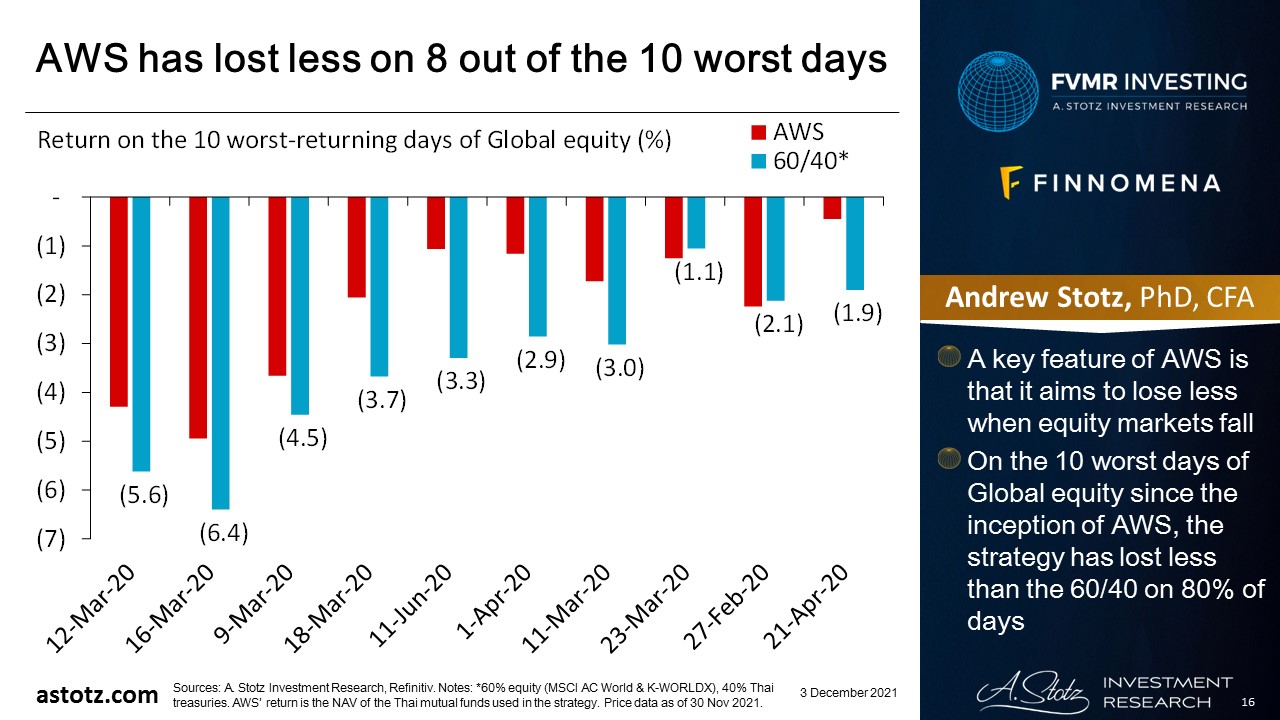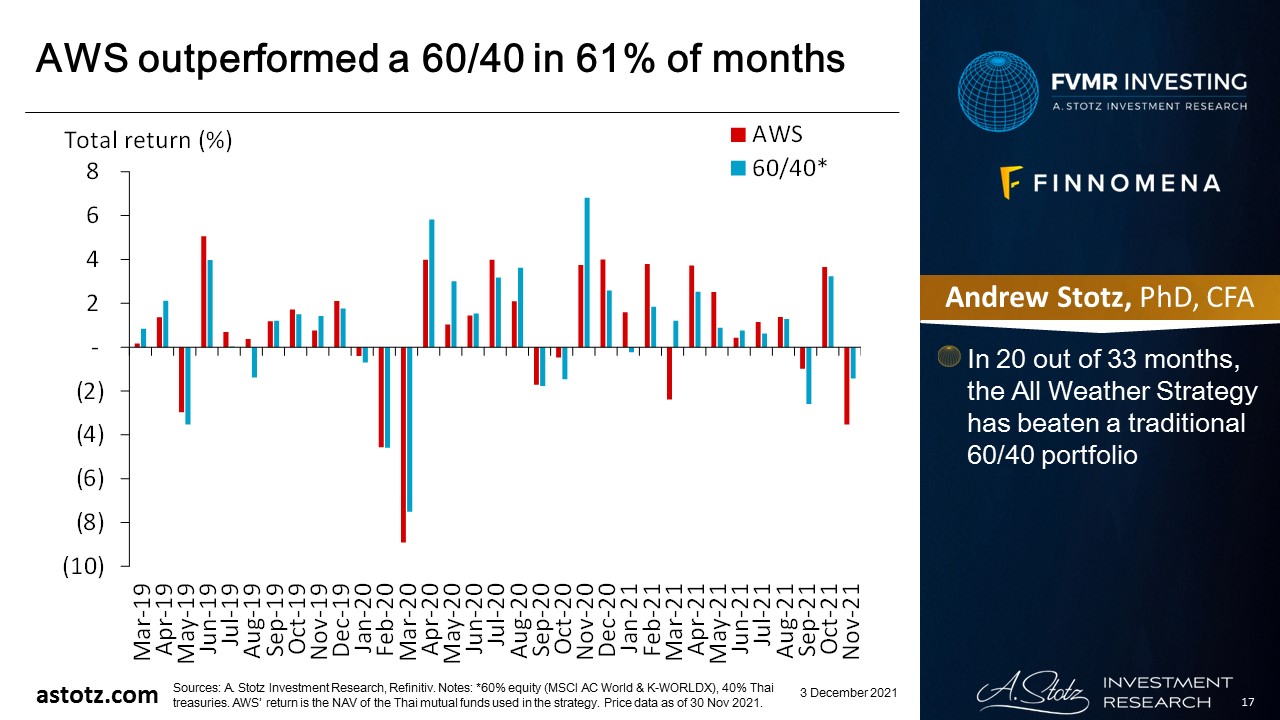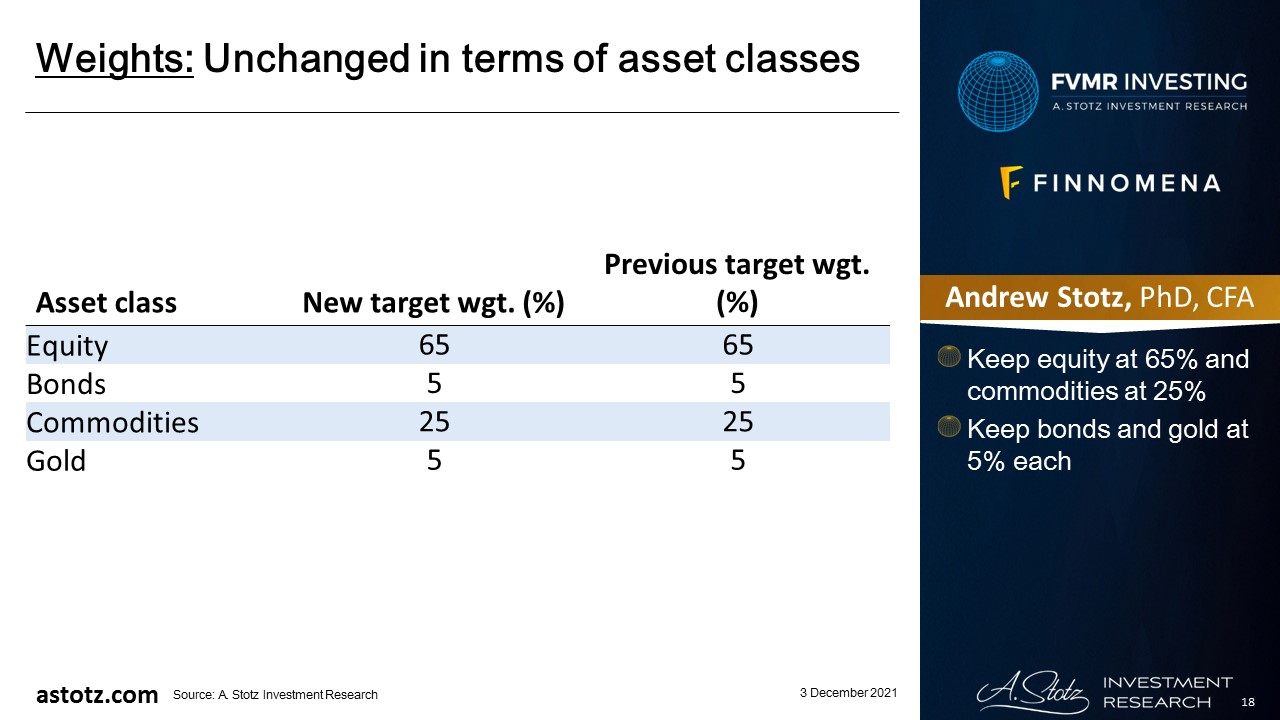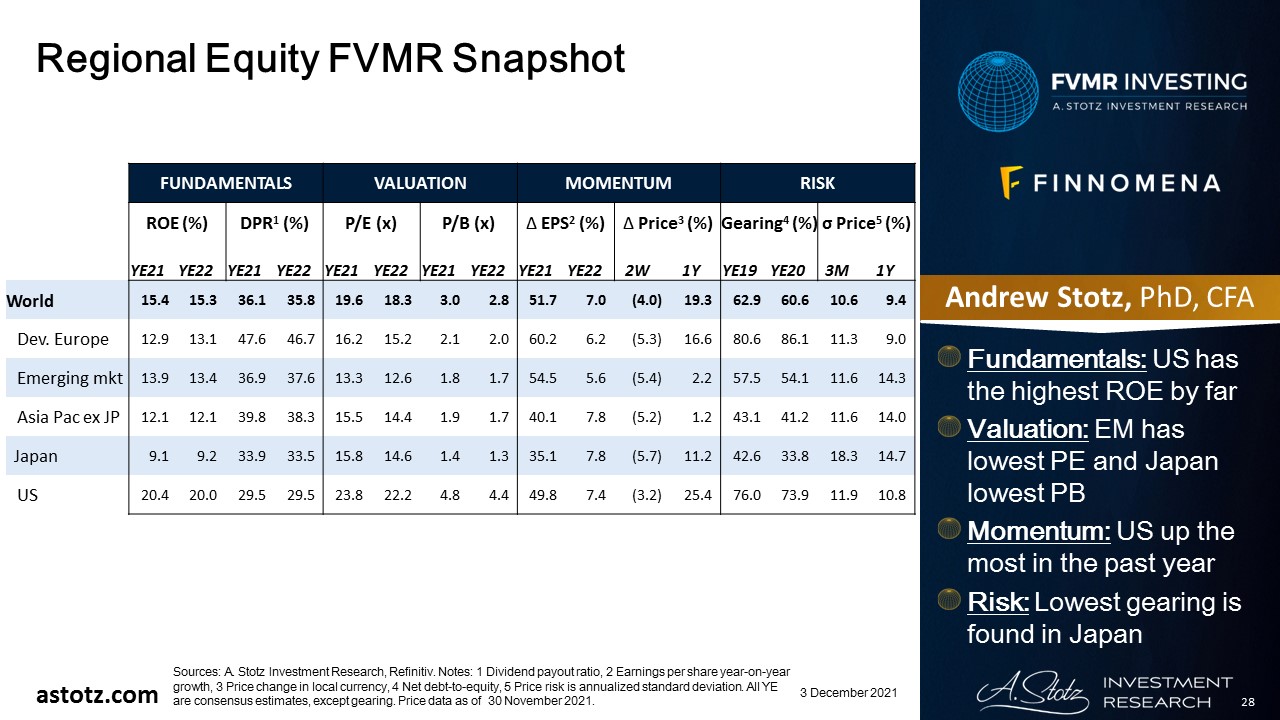A. Stotz All Weather Strategy – November 2021
The All Weather Strategy performed in line with a traditional 60/40 portfolio in the past three months. Fed/ECB unwillingness to taper could drive equities higher. Commodities driven by the energy crisis and supply-chain disruption. We keep our target allocations unchanged. Risks: Inflation turns out transitory, new lockdowns, US default.
The A. Stotz All Weather Strategy is Global, Long-term, and Diversified:
- Global – Invests globally, not only Thailand
- Long-term – Gains from long-term equity return, while trying to reduce a portion of losses during equity market downturns
- Diversified – Diversified globally across four asset classes
The All Weather Strategy is available in Thailand through FINNOMENA. Please note that this post is not investment advice and should not be seen as recommendations. Also, remember that backtested or past performance is not a reliable indicator of future performance.
Review
US has driven global equity
Heavy in Western Developed markets
- In our June revision, we switched our 25% equity allocations to the US and Developed Europe from Emerging markets and Asia Pacific ex Japan
- We made no change in the September revision
Omicron news shook equity markets
- When the Omicron variant of the virus hit the global newswires, uncertainty and fear of lockdowns returned to the markets
- World equity fell as a result at the end of November 2021 and wiped out most gains in equity markets in the past three months
- Only the US market closed up
Europe ranked third among equity
- We based our tilt on Europe opening up, and that ECB would not start battling inflation yet
- Amidst uncertainty and fear of lockdowns returning to the markets, Developed Europe kept up well compared to Emerging markets and Asia Pacific ex Japan
EM and Asia underperformed
- Worries about new lockdowns following Omicron, or slower reopening have been muting performance
- Chinese government intervention in the Evergrande debacle has been a drag on Chinese stocks
- China constitutes a large part of Emerging Markets and Asia Pacific ex Japan
Low bond target allocation at 5%
- We have a bond target allocation of 5% as they appeared less attractive relative to equity
- The strategy is to hold only Thai government bonds, rather than a mix of global government and corporate bonds
- Besides US equity, other assets were down in the past three months; hence, a larger allocation to bonds would have been better
Energy constituted a drag
- Energy dropped by 17% in November, which resulted in an overall slightly negative performance for commodities
Gold was slightly down
- We have a minimum 5% allocation to gold
- As Jerome Powell was reappointed Fed Chair, the US Dollar strengthened reflecting investor confidence, and conversely the Gold price fell back in the past three months
- Gold closed November at US$1,774/oz t
Past 3 months: Only US and bonds were up
- AWS: 0.1% below the traditional 60/40 portfolio
- US: The best performer
- Dev. Europe: third-best performing equity
- Commodities: Third-best performing asset
Slightly below a traditional 60/40 portfolio
Past performance should not be taken as an indication or guarantee of future performance, and no representation or warranty, expressed or implied is made regarding future performance.
- Since inception, the All Weather Strategy has mostly had a 45-65% equity target weight and a 25% gold allocation
- Reduced downside compared to an equity-only strategy
AWS has experienced less volatility than a 60/40
- Mostly 25-65% target weight for equity has reduced volatility
- Since gold is generally uncorrelated to equity, it has reduced the overall AWS volatility
AWS has lost less on 8 out of the 10 worst days
- A key feature of AWS is that it aims to lose less when equity markets fall
- On the 10 worst days of Global equity since the inception of AWS, the strategy has lost less than the 60/40 on 80% of days
AWS outperformed a 60/40 in 61% of months
- In 20 out of 33 months, the All Weather Strategy has beaten a traditional 60/40 portfolio
Weights: Unchanged in terms of asset classes
- Keep equity at 65% and commodities at 25%
- Keep bonds and gold at 5% each
Weights: No changes in regional target weights
- We keep US and Developed Europe at 25%
Outlook
Equity to recover quickly
- While news about Omicron initially shook financial markets, the current assessment is that the variant is less severe (just more contagious) than previous variants
- Assuming that’s right, the virus itself is unlikely to impact markets negatively
- Hence, equity markets should be able to recover from the recent turmoil
Fed unlikely to taper
- “I do think it’s time to taper; I don’t think it’s time to raise rates,” said Powell on October 22
- Since then, he has been reappointed and communicated that pandemic support should be reduced at a faster pace and that inflation may not be “transitory”
- Chairman Powell confirmed our expectation that Fed may reduce its asset purchasing this year, but won’t bring on rising interest rates
Fed continues to prop up the US market
- High US Gov’t debt load is likely to keep the Fed from raising rates too fast or by too much
- The market is currently pricing in a 70% chance of a rate hike in June 2022; versus in October when it only priced in a 50% probability of a rate hike in September 2022
- We expect the Fed to continue doing what it can to prop up the US market; US equity should be able to recover from the recent fall
EU is unlikely to taper this year too
- ECB President Lagarde is still sticking to the “inflation is transitory” narrative
- She has said she will stop the Pandemic Emergency Purchase Programme (PEPP) by March 2022, but other QE may continue
- Yet no tapering decision and inflation should be positive for European equity
China remains uncertain
- Investors are concerned about continued Chinese Gov’t clampdowns and the health of the Chinese Real Estate sector
- Continued uncertainty is negative for China equity, and its heavy weight in the Emerging markets and Asia Pacific ex Japan indices is likely to drag on performance
Bonds to remain flattish
- As we’re expecting rising inflation, we expect bonds to underperform
- This is reflected in our 5% target allocation
Still bullish on commodities
- We expect energy prices to rebound, as the supply-demand imbalance is likely to remain
- Poor weather conditions and high natural gas prices lead to higher fertilizer costs, which feeds through to soft commodities
- Global supply-chain disruption due to government-mandated economic shutdowns could become more permanent, pushing up prices further
Still no catalyst for gold
- In the longer term, as the inflation narrative spreads, it could lead to expectations of negative real rates; supportive of the gold price
- We don’t expect Fed and ECB to make any surprising statements, so we don’t see their communication pushing gold in either direction
Regional Equity FVMR Snapshot
- Fundamentals: US has the highest ROE by far
- Valuation: EM has lowest PE and Japan lowest PB
- Momentum: US up the most in the past year
- Risk: Lowest gearing is found in Japan
Risks
Inflation turns out transitory
- The All Weather Strategy is positioned to benefit from rising inflation
- There’s a risk that inflation is transitory, which could hurt our performance
- Besides, return expectations in inflationary environments are based upon corresponding rising interest rates
- But the Fed and ECB are expected to keep rates low at least until late 2022
New variants lead to new lockdowns
- If governments in countries with high vaccination rates return to lockdowns to battle new mutations of the virus, it would be negative for those equity markets
- If we see large parts of the world being shut down again, it could also reduce demand for commodities
US default
- While the American Congress has bought more time by raising the debt ceiling, it may need to deal with it again soon
- If the US defaults, this could have serious negative consequences for US equity, and possible global equities too
DISCLAIMER: This content is for information purposes only. It is not intended to be investment advice. Readers should not consider statements made by the author(s) as formal recommendations and should consult their financial advisor before making any investment decisions. While the information provided is believed to be accurate, it may include errors or inaccuracies. The author(s) cannot be held liable for any actions taken as a result of reading this article.










